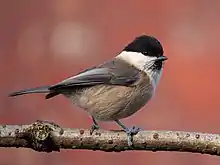小雀
Japanese
Etymology 1
| Kanji in this term | |
|---|---|
| 小 | 雀 |
| こ Grade: 1 |
がら Jinmeiyō |
| kun’yomi | irregular |
Attested from at least the 13th century. Origin is uncertain. One theory suggests shortening from an earlier 小雀目 (kogarame), meaning roughly “small birds that fly in a flock”. Others suggest shortening from 小山潜群, which in turn is from 小 (ko-, “small”) plus 山潜群 (yamakugurimure), an obsolete form of 山雀 (yamagara, “varied tit”).[1] Compare also エボシガラ (eboshigara, “tufted titmouse”), 四十雀 (shijūkara, “Japanese tit”).

コガラ or willow tit, Poecile montanus
Pronunciation
Alternative forms
- (baby sparrow): 子雀
References
- 1988, 国語大辞典(新装版) (Kokugo Dai Jiten, Revised Edition) (in Japanese), Tōkyō: Shogakukan
This article is issued from Wiktionary. The text is licensed under Creative Commons - Attribution - Sharealike. Additional terms may apply for the media files.